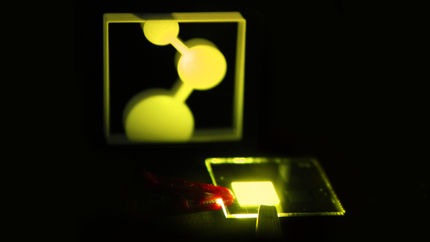Printable luminous particles enable cost-effective, large and curved luminous surfaces
Researchers at the INM – Leibniz Institute for New Materials have now developed a new method that enables electroluminescence on large, curved surfaces in a cost-effective way: in this case, the light-emitting layer and all other components are produced by means of wet-chemical, printable methods.
Light-emitting diodes (LEDs) are the modern lighting devices used in lamps, signals, signs or displays. By contrast, organic semiconducting light-emitting materials (OLEDs) can be incorporated in thin layers and used on curved surfaces. However, OLEDs for large-area illumination are cost-intensive at present owing to their low efficiency and short lifetime.
One promising alternative for modern lighting is electroluminescence. Special nanoparticles, so-called phosphors, are excited in an electric field to emit light. Researchers at the INM – Leibniz Institute for New Materials have now developed a new method that enables electroluminescence on large, curved surfaces in a cost-effective way: in this case, the light-emitting layer and all other components are produced by means of wet-chemical, printable methods.
“For processing we only need temperatures below 200 degrees Celsius. This means that we can apply all the required partial layers even to films or other flexible substrates,” explains Peter William de Oliveira, head of the program division Optical Materials. Hence, “luminous surfaces” could be produced very cost-effectively and even in large formats.
The luminous unit consists of two electrically conductive layers, between which the light-emitting particles are sandwiched in a dielectric binder layer. At least one of the conductive layers is also transparent. Due to the insulating layer, the absorbed energy is efficiently converted into light and appreciable heating is avoided. On application of an AC voltage, light is emitted from the electroluminescent layer. “We embed luminous particles in the form of functionalized zinc sulphide nanoparticles as phosphors into the binder layer,” explains de Oliveira “these are doped with copper or manganese. At present this allows the generation of green and blue-green light.”
The electroluminescent light sheets developed at the INM can be directly connected to the customary mains voltage of 230 volts. Rectifiers, ballast capacitors or other switching units that first adapt the voltage can be omitted.
The researchers are currently working on further functionalization of the phosphor nanoparticles. “Our goal is to generate white light by means of an altered doping or by introducing coloured pigments into the luminous layer,” says physicist de Oliveira. At the same time the developers want to alter the materials in such a way that the light sheets can be used even at a lower mains voltage.
Most read news
Organizations
Other news from the department science
These products might interest you

NANOPHOX CS by Sympatec
Particle size analysis in the nano range: Analyzing high concentrations with ease
Reliable results without time-consuming sample preparation

DynaPro Plate Reader III by Wyatt Technology
Screening of biopharmaceuticals and proteins with high-throughput dynamic light scattering (DLS)
Efficiently characterize your sample quality and stability from lead discovery to quality control

Eclipse by Wyatt Technology
FFF-MALS system for separation and characterization of macromolecules and nanoparticles
The latest and most innovative FFF system designed for highest usability, robustness and data quality

Get the chemical industry in your inbox
By submitting this form you agree that LUMITOS AG will send you the newsletter(s) selected above by email. Your data will not be passed on to third parties. Your data will be stored and processed in accordance with our data protection regulations. LUMITOS may contact you by email for the purpose of advertising or market and opinion surveys. You can revoke your consent at any time without giving reasons to LUMITOS AG, Ernst-Augustin-Str. 2, 12489 Berlin, Germany or by e-mail at revoke@lumitos.com with effect for the future. In addition, each email contains a link to unsubscribe from the corresponding newsletter.



















































